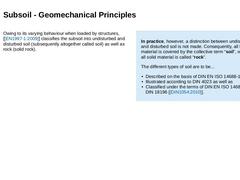
|
Owing to its varying behaviour when loaded by structures, [ [EN1997-1:2009]] classifies the subsoil into undisturbed and disturbed soil (subsequently altogether called soil) as well as rock (solid rock). In practice, however, a distinction between undisturbed and disturbed soil is not made. Consequently, all loose material is covered by the collective term “soil”, whereas all solid material is called “rock”. The different types of soil are to be...… |
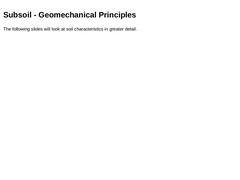
|
The following slides will look at soil characteristics in greater detail. |
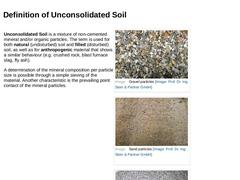
|
|
Unconsolidated Soil is a mixture of non-cemented mineral and/or organic particles. The term is used for both natural (undisturbed) soil and filled (disturbed) soil, as well as for anthropogenic material that shows a similar behaviour (e.g. crushed rock, blast furnace slag, fly ash). A determination of the mineral composition per particle size is possible through a simple sieving of the material. Another characteristic is the prevailing point contact … |
|
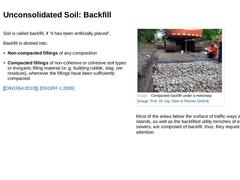
|
Soil is called backfill, if “it has been artificially placed”. Backfill is divided into: -
Non-compacted fillings of any composition
-
Compacted fillings of non-cohesive or cohesive soil types or inorganic filling material (e. g. building rubble, slag, ore residues), whenever the fillings have been sufficiently compacted
[ [DIN1054:2010]], [EN1997-1:2009] (Image: Compacted backfill under a motorway) Most of the areas below the surface of traffic ways and … |
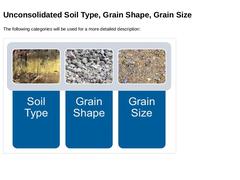
|
The following categories will be used for a more detailed description: (Image: Unconsolidated soil categories) |

|
|
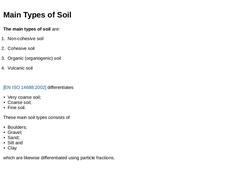
|
The main types of soil are: -
Non-cohesive soil
-
Cohesive soil
-
Organic (organogenic) soil
-
Vulcanic soil
[[EN ISO 14688:2002]] differentiates -
Very coarse soil;
-
Coarse soil;
-
Fine soil.
These main soil types consists of -
Boulders;
-
Gravel;
-
Sand;
-
Silt and
-
Clay
which are likewise differentiated using particle fractions. |
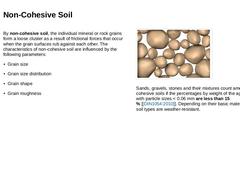
|
By non-cohesive soil, the individual mineral or rock grains form a loose cluster as a result of frictional forces that occur when the grain surfaces rub against each other. The characteristics of non-cohesive soil are influenced by the following parameters: -
Grain size
-
Grain size distribution
-
Grain shape
-
Grain roughness
(Image: Non-cohesive soil particles, held loosely together through the grain surface friction) Sands, gravels, stones and their … |
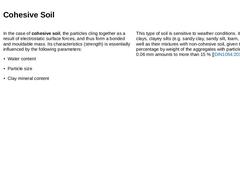
|
In the case of cohesive soil, the particles cling together as a result of electrostatic surface forces, and thus form a bonded and mouldable mass. Its characteristics (strength) is essentially influenced by the following parameters: -
Water content
-
Particle size
-
Clay mineral content
This type of soil is sensitive to weather conditions. it includes clays, clayey silts (e.g. sandy clay, sandy silt, loam, marl) as well as their mixtures with non-cohesive … |
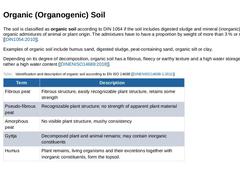
|
The soil is classified as organic soil according to DIN 1054 if the soil includes digested sludge and mineral (inorganic) soils with organic admixtures of animal or plant origin. The admixtures have to have a proportion by weight of more than 3 % or rather 5 % [ [DIN1054:2010]]. Examples of organic soil include humus sand, digested sludge, peat-containing sand, organic silt or clay. Depending on its degree of decomposition, organic soil has a fibrous, … |
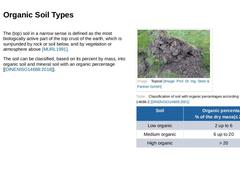
|
The (top) soil in a narrow sense is defined as the most biologically active part of the top crust of the earth, which is surrpunded by rock or soil below, and by vegetation or atmosphere above [MURL1991]. The soil can be classified, based on its percent by mass, into organic soil and mineral soil with an organic percentage [ [DINENISO14688:2018]]. (Image: Topsoil) (Table: Classification of soil with organic percentages according to EN ISO 14688-2) |
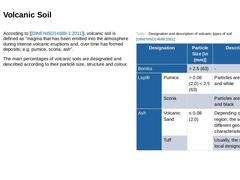
|
According to [ [DINENISO14688-1:2011]], volcanic soil is defined as “magma that has been emitted into the atmosphere during intense volcanic eruptions and, over time has formed deposits; e.g. pumice, scoria, ash”. The main percentages of volcanic soils are designated and described according to their particle size, structure and colour. (Table: Designation and description of volcanic types of soil [ENISO14688]) |

|
|
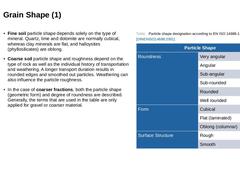
|
-
Fine soil particle shape depends solely on the type of mineral. Quartz, lime and dolomite are normally cubical, whereas clay minerals are flat, and halloysites (phyllosilicates) are oblong.
-
Coarse soil particle shape and roughness depend on the type of rock as well as the individual history of transportation and weathering. A longer transport duration results in rounded edges and smoothed out particles. Weathering can also influence the particle …
|
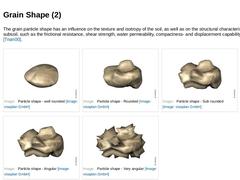
|
The grain particle shape has an influence on the texture and isotropy of the soil, as well as on the structural characteristics of the subsoil, such as the frictional resistance, shear strength, water permeability, compactness- and displacement capability [Soos96] [Trian00]. (Image: Particle shape - well rounded) (Image: Particle shape - Rounded) (Image: Particle shape - Sub rounded) (Image: Particle shape - Angular) (Image: Particle shape - Very … |

|
|
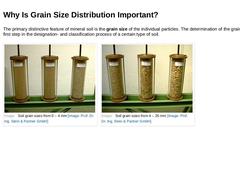
|
The primary distinctive feature of mineral soil is the grain size of the individual particles. The determination of the grain size is the first step in the designation- and classification process of a certain type of soil. (Image: Soil grain sizes from 0 – 4 mm) (Image: Soil grain sizes from 4 – 25 mm) |
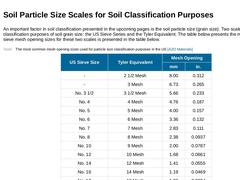
|
An important factor in soil classification presented in the upcoming pages is the soil particle size (grain size). Two scales are used for classification purposes of soil grain size: the US Sieve Series and the Tyler Equivalent. The table below presents the most common sieve mesh opening sizes for these two scales is presented in the table below. (Table: US sieve mesh size) |
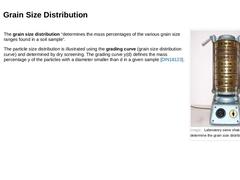
|
|
The grain size distribution “determines the mass percentages of the various grain size ranges found in a soil sample”. The particle size distribution is illustrated using the grading curve (grain size distribution curve) and determined by dry screening. The grading curve y(d) defines the mass percentage y of the particles with a diameter smaller than d in a given sample [DIN18123]. |
(Image: Laboratory sieve shaker used to determine the grain size … |
|
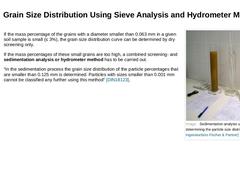
|
|
If the mass percentage of the grains with a diameter smaller than 0.063 mm in a given soil sample is small (≤ 3%), the grain size distribution curve can be determined by dry screening only. If the mass percentages of these small grains are too high, a combined screening- and sedimentation analysis or hydrometer method has to be carried out. “In the sedimentation process the grain size distribution of the particle percentages that are smaller than … |
|
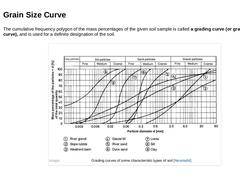
|
The cumulative frequency polygon of the mass percentages of the given soil sample is called a grading curve (or grain size curve), and is used for a definite designation of the soil. (Image: Grading curves of some characteristic types of soil [Neuma64]) |
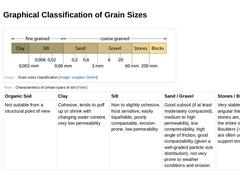
|
(Image: Grain sizes classification) (Table: Soil characteristics) |
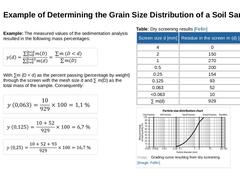
|
Example: The measured values of the sedimentation analysis resulted in the following mass percentages: (Formula: Aus den Messwerten der Siebanalyse folgten die Gewichtsanteile) With ∑m (D < d) as the percent passing (percentage by weight) through the screen with the mesh size d and ∑ m(D) as the total mass of the sample. Consequently: (Formula: Gewichtsanteil y(0,063)) (Formula: Gewichtsanteil y(0,125)) (Formula: Gewichtsanteil y(0,25)) |
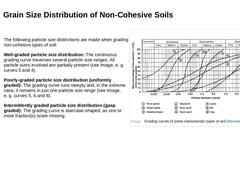
|
|
The following particle size distinctions are made when grading non-cohesive types of soil: Well-graded particle size distribution: The continuous grading curve traverses several particle size ranges. All particle sizes involved are partially present (see Image, e. g. curves 3 and 4). Poorly-graded particle size distribution (uniformly graded): The grading curve runs steeply and, in the extreme case, it remains in just one particle size range (see … |
|
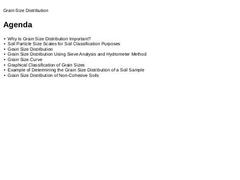
|
|